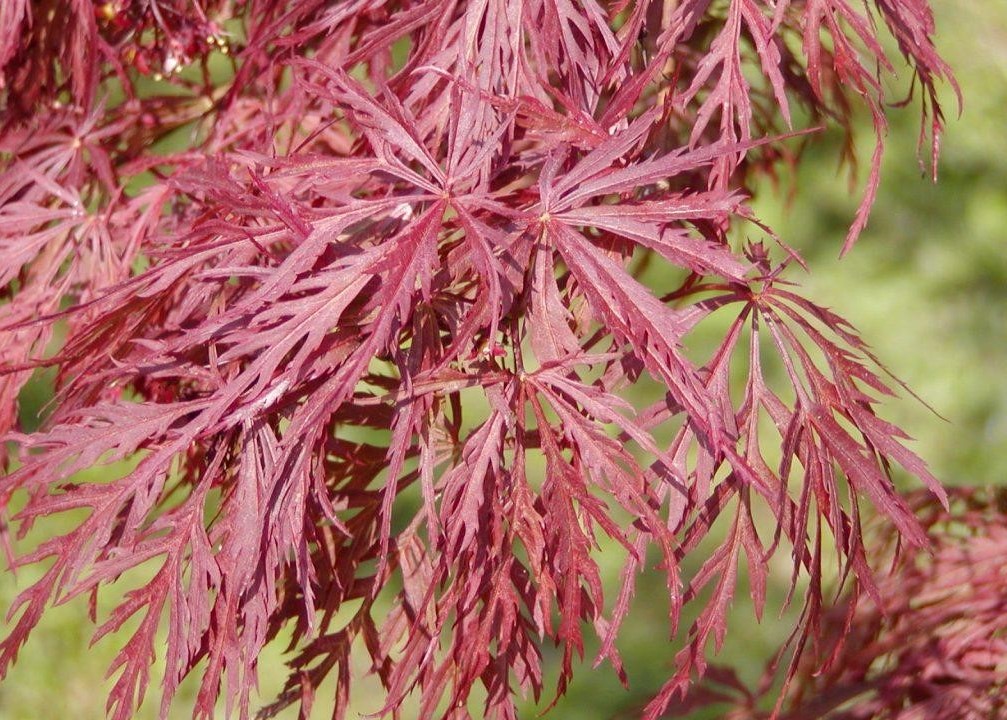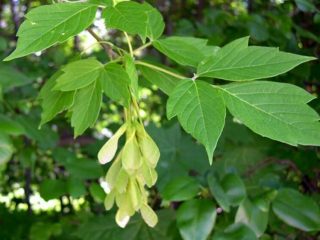Content
Palm maple is an ornamental plant native to Japan. The tree differs from other representatives of the Sapindaceae family by its highly branched trunk and deeply dissected leaves with pointed tips.

In Japan, a beautiful tree is called “frog legs” for its leaves with elongated ends.
Description of palmate maple
The Japanese palm maple got its name due to the shape of its leaves, which look like outstretched palms (palm is an Old Russian word). The ornamental plant is a small deciduous tree 6-10 m high or a spreading shrub. The trunk, which is even in the lower part, gradually branches, which is why palm maple is also called fan maple. As the tree matures, the round crown becomes more and more asymmetrical, looking like a tent.
The leaves of different varieties differ from each other, but in any case the shape resembles a palm with outstretched fingers.At the end of spring, the plant blooms, after which winged seeds are formed, which are carried by the wind throughout the surrounding area.
Varieties of palm maple
Currently, about 1000 varieties of maple are known. Species differ in size, crown type, leaf shape and color. Biologists distinguish several varieties of fan-shaped maple Acer Palmatum (finger-shaped). This is the basis for the plant classification, which should be followed when purchasing seedlings and seeds. There are some varieties that are the most popular.
Maple Atropurpureum
Fan maple Atropurpureum is a variety represented by trees and shrubs. Its crown shape is spherical or similar to an open umbrella. Leaf plates consist of 5-9 “fingers”. The tree grows slowly and becomes wider with age. The root system is powerful. The variety is demanding on the composition and structure of the soil.

When the plant is young, the foliage is deep red; the color becomes darker over the years.
Butterfly
Variety Butterfly is a bush with equal height and width (up to 4 m). The plant has green leaves with a striking white border.

The crown shape of the Butterfly variety is spherical, and the branches are low
Dissectum Ornatum
Maple Dissectum has high decorative qualities. The species includes several varieties of trees, one of which is Ornatum. Trees rarely reach 3 m in height. The maple variety Dissectum Ornatum has strongly curved branches.

The Dissectum Ornatum variety is attractive with red-orange leaf blades
Dissectum Atropupureum
The shrub or tree has small leaves.A peculiarity of the variety is that the plant is smaller in height than in width.

The height of the Dissectum Atropurpureum tree is 2.5 m, while the crown girth is 3 m
Dissectum Nigrum
The decorative variety is distinguished by its unusual purple foliage color. The height from the ground to the top is approximately equal to the width of the crown.

The purple color of the leaves gives the Nigrum maple a fantastic look
Maple Katsura
Katsura is a dwarf variety of palmar maple. The maximum height of the tree is 1.8 m.

The Katsura variety has green leaves with very pointed tips.
Summer Gold
Multi-stemmed shrub or tree no more than 3 m in size. The Summer Gold species has bright, yellow-orange leaves. In temperate climates, the delicate plant requires shelter for the winter.

Summer Gold's golden foliage stays richly colored throughout the summer.
Phoenix maple (Phoenix)
A low tree looks especially sophisticated. In the spring, the Phoenix maple has pink foliage with yellow veins, changing color to green in the summer and burgundy in the fall.

The Phoenix variety is winter-hardy, the plant can tolerate fairly severe frosts
Seiryu
The beautiful name of the palmate maple Seiryu is translated from Japanese in a very romantic way - “shooting star”. The plant has soft, hanging branches.

Seiryu - the most weeping variety of palm maple
Planting palm maple
Planting of fan maple should take into account the climatic conditions of the region where it is intended to be grown. Most tree species are heat-loving crops. Not all plant varieties are suitable for cultivation in the temperate natural zone. At a temperature of -28 0The tree will freeze and may die. The optimal climate for growing is warm and humid, with mild winters. When deciding on a place to plant a palmate maple, it is important to consider a number of factors. Agricultural technicians consider the following to be the most significant:
- the site should be located in a place illuminated by the sun or in partial shade;
- areas protected from winds are suitable for cultivation;
- To grow a tree, neutral or acidic soil is required.
The first ten years the culture develops very slowly. Over time, the plant will acclimatize and strengthen, it will form an extensive root system, and the above-ground mass will become much larger.
Reproduction
Palm maples propagate in two ways: cuttings and seeds. The first option is available even to amateur gardeners. But propagation by seeds is a long and quite labor-intensive process. Sowing includes agrotechnical operations:
- Planting material is subjected to stratification in advance. The seeds are kept in the refrigerator at temperatures from 00 up to +50C for 9-12 weeks.
- In April, a soil mixture is prepared consisting of humus, earth, sand in a ratio of 3:2:1.
- The seed material is soaked for three days in a weak solution of hydrogen peroxide.
- Choose a fairly spacious container for growing. Seeds are planted to a depth of 3-4 cm.
After about three weeks, shoots appear. The young tree continues to grow in the same container. Seedlings need regular care.They are kept in a bright room, avoiding direct sunlight. The plant is systematically watered and the soil is loosened. Transplantation into open ground is possible after a year, but agricultural technicians advise transferring the maple to the site three years after sowing the seeds. Grown bushes have good immunity and will take root better in the garden.
Decorative plant forms are best propagated by cuttings. Planting palm maple and caring for it in the Moscow region has its own peculiarities. Experienced gardeners share their findings that allow them to cultivate a heat-loving plant in the Russian winter:
- Cuttings are carried out in spring or early autumn.
- Prepare a pit 70 cm deep, 50 cm long and 50 cm wide in advance.
- The bottom is loosened using a fork and a drainage layer is formed.
- When planting, mineral fertilizer is applied.
- Carefully lower the cutting into the ground, protecting the roots.
- The hole is covered with soil. At the same time, make sure that the root collar is at ground level.
Some gardeners grow Japanese maples outdoors in large plant pots. With this method of cultivation, it is important to know that the plant needs several months of rest every year. Therefore, when the temperature drops noticeably, seedlings are brought not into the house, but into a cool basement. It will be possible to put the palmate maple outside as soon as the air temperature rises to +2-5 0C. When the tree grows and gets stronger, they organize its transfer to open ground.
Caring for palm maple
In the first years, caring for plantings takes a lot of time. Palm maple needs regular watering. It is also necessary to moisten the foliage from time to time using a spray bottle. In dry summers, water once a week.In this case, each specimen requires 15 liters of water. The rest of the time, the frequency of watering is 1-2 times a month. Irrigation of foliage is organized in the evening to prevent the formation of burns.
In summer, trees and shrubs are fed with fertilizers intended for heather crops. Excess chemicals can cause the development of fungal diseases, so the recommended dosage and frequency of fertilizing should be strictly observed. In August, nitrogen compounds are no longer used, and in early September, the plantings are fertilized with a phosphorus-potassium complex. The measure is aimed at accelerating the maturation of wood, which will help the plant survive the winter.
In autumn, the remaining leaves are removed and the fallen ones are destroyed to eliminate pests. The tree trunk circle is mulched with pine needles or peat to protect the roots from freezing.
Features of cultivating palm maple in temperate climates are presented in the video:
Application
Japanese maples are most suitable for gardens and parks decorated in a southeastern style. Ensembles consisting of trees of the same or different species in landscape formations occupying a vast territory look organic.

Single specimens of palmate maple can decorate a small garden or square
Designers often use shrubby forms as hedges. To do this, plants are regularly pruned so that new shoots are more actively formed. Bushes are also used as borders. Plantings are often trimmed, thus maintaining a presentable appearance.Low palm-shaped maple bushes can become the center of a composition in a rock garden.
In addition to their striking external beauty, many varieties of fan maple are excellent honey plants. Trees grown near the apiary are popular with bees during the flowering period, from mid-May to the end of June.
Conclusion
The palmate maple evokes universal admiration for the unusual color of the foliage and the graceful curves of its numerous shoots. For cultivating a heat-loving plant in a continental climate with frosty winters, cold-resistant, viable varieties are most suitable. It is equally important to impeccably follow the rules of agricultural technology when planting and caring for a capricious tree. Under such conditions, a fabulously beautiful decorative culture will become a real decoration of the territory.












